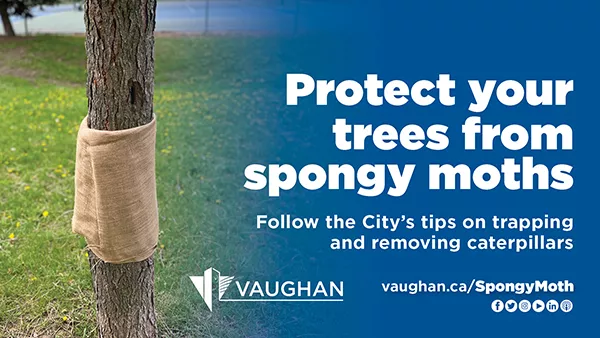Protect your trees from spongy moths
Spongy moths are once again making a home for themselves
in Vaughan, and, this time of year, they’re emerging as caterpillars. The spongy
moth caterpillars are orange, brown and black, and they eat leaves from hardwood trees such as oak, maple, birch and poplar,
and select shrubs. As the City of Vaughan’s staff continues to control the
population on municipal trees, there are also a few steps you can take to help
protect trees on your property.
What you can do:
The following precautions can be taken from now to August:
- Trap caterpillars by wrapping burlap around tree trunks to make it easier to collect them. Check your burlap band daily, remove trapped caterpillars and place them in a bucket of soapy water for at least two days before disposing of the insects in the garbage. You can also watch the City’s instructional video showing you how to use the burlap.
Do you need burlap bands? The City still has free kits available (one per household) at the following locations:
- Maple Community Centre
- Chancellor Community Centre
- North Thornhill Community Centre
The kits are available on a first-come, first-served basis. Visit the City’s website for community centre locations and hours of operation.
What the City is doing:
City staff began inspections of more than 8,000 City-owned trees in April throughout heavily infested areas. Staff have effectively removed egg masses from more than 3,000 trees so far this season. The City continues to implement the following control measures this time of year:
- In May, the City began applying Btk sprays (a biological control product that is non-toxic to animals, humans, plants and most other insects) at select park locations. Also in May, the City installed barrier bands on vulnerable trees in street and park locations with high levels of infestation.
- In June, City contractors will begin injecting TreeAzin™ (a biological control product) in trunks of many heritage trees and priority hotspot woodlot locations, as well as continuing to install barrier bands.
For more information and links to resources, visit vaughan.ca/SpongyMoth, the Ministry of Agriculture, Food and Rural Affair’s webpage or york.ca/SpongyMoth.
For updates and news as they happen, subscribe to Vaughan News and follow the official corporate channels on Twitter, Facebook, Instagram and LinkedIn.
-30-

